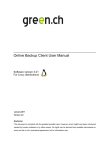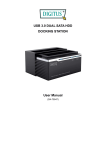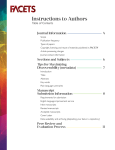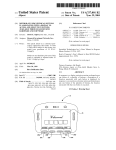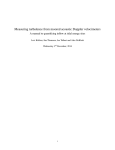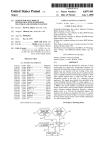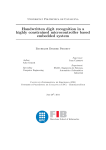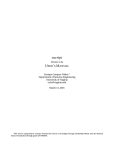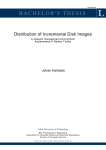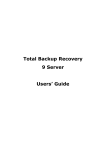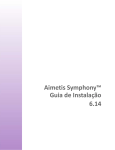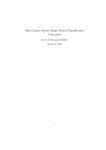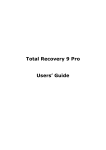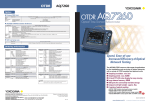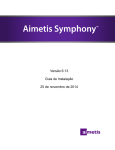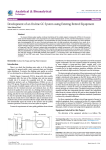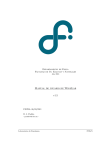Download S1 Document.
Transcript
RIPScore
(v1.2)
User Manual
Copyright © 2015, Carlos Alejandro Robles Rubio, Karen A. Brown, and Robert E. Kearney
McGill University
Table of Contents
I.
LICENSE.................................................................................................................................................... 3
II.
ACKNOWLEDGEMENT .............................................................................................................................. 4
III.
QUICK START ........................................................................................................................................... 5
A.
B.
C.
DESCRIPTION ........................................................................................................................................................5
REQUIRED LIBRARIES ..............................................................................................................................................5
RUN RIPSCORE .....................................................................................................................................................5
IV.
CONFIGURATION ..................................................................................................................................... 8
V.
DATA FILES..............................................................................................................................................12
A.
B.
INPUT................................................................................................................................................................12
OUTPUT ............................................................................................................................................................12
VI.
LIST OF ACRONYMS .................................................................................................................................16
VII.
REFERENCES............................................................................................................................................17
2/17
I. License
Copyright (c) 2015, Carlos Alejandro Robles Rubio, Karen A. Brown, and Robert E. Kearney,
McGill University
All rights reserved.
Redistribution and use in source and binary forms, with or without modification, are permitted provided
that the following conditions are met:
1. Redistributions of source code must retain the above copyright notice, this list of conditions and the
following disclaimer.
2. Redistributions in binary form must reproduce the above copyright notice, this list of conditions and
the following disclaimer in the documentation and/or other materials provided with the distribution.
THIS SOFTWARE IS PROVIDED BY THE COPYRIGHT HOLDERS AND CONTRIBUTORS "AS IS" AND ANY
EXPRESS OR IMPLIED WARRANTIES, INCLUDING, BUT NOT LIMITED TO, THE IMPLIED WARRANTIES OF
MERCHANTABILITY AND FITNESS FOR A PARTICULAR PURPOSE ARE DISCLAIMED. IN NO EVENT SHALL
THE COPYRIGHT HOLDER OR CONTRIBUTORS BE LIABLE FOR ANY DIRECT, INDIRECT, INCIDENTAL,
SPECIAL, EXEMPLARY, OR CONSEQUENTIAL DAMAGES (INCLUDING, BUT NOT LIMITED TO,
PROCUREMENT OF SUBSTITUTE GOODS OR SERVICES; LOSS OF USE, DATA, OR PROFITS; OR BUSINESS
INTERRUPTION) HOWEVER CAUSED AND ON ANY THEORY OF LIABILITY, WHETHER IN CONTRACT, STRICT
LIABILITY, OR TORT (INCLUDING NEGLIGENCE OR OTHERWISE) ARISING IN ANY WAY OUT OF THE USE OF
THIS SOFTWARE, EVEN IF ADVISED OF THE POSSIBILITY OF SUCH DAMAGE.
3/17
II. Acknowledgement
The development of RIPScore was supported in part by the Natural Sciences and Engineering Research
Council of Canada. The work of Carlos Alejandro Robles Rubio was supported in part by the Mexican
National Council for Science and Technology, and in part by the Queen Elizabeth Hospital of Montreal
Foundation Chair in Pediatric Anesthesia. Karen A. Brown was supported in part by the Queen Elizabeth
Hospital of Montreal Foundation Chair in Pediatric Anesthesia.
4/17
III.Quick Start
A. Description
RIPScore is an open source, interactive software application for manual scoring of infant Respiratory
Inductive Plethysmography (RIP) data. A detailed description of the analysis that can be performed using
RIPScore is in [1]. RIPScore was developed in MATLABTM (The MathWorks, Inc., Natick, MA, USA).
B. Required Libraries
It is necessary to obtain the following libraries to use RIPScore.
1) McCRIBS (McGill CardioRespiratory Infant Behavior Software) tools. These tools are open source
functions developed in MATLABTM, and are available for download free of charge at
github.com/McCRIBS. Download the tools and save them in the directory
C:\McCRIB\McCRIBS.
2) A library of “true-pattern” segments as defined in [1]. This library is available for download free
of charge at datadryad.org (for details see [1]). Download the data and save them in the
directory C:\McCRIB\Data.
C. Run RIPScore
The following steps provide a guide to start using RIPScore with default configuration parameters.
1) Open MATLABTM.
2) Setup the McCRIBS working environment in MATLABTM. by running this code:
%Path to the McCRIBS tools directory (downloaded from github.com)
SourceCodeRoot='C:\McCRIB\McCRIBS';
%Path to the Data directory (downloaded from datadryad.org)
DataRoot='C:\McCRIB\Data';
%Setup the working environment
cd([SourceCodeRoot '\Utilities']);
setMcCRIBS_Env(SourceCodeRoot,DataRoot)
McCRIB_DATA_ROOT=getenv('McCRIB_DATA_ROOT'); %The Data directory.
%Go to RIPScore root directory
cd([SourceCodeRoot '\RIPSCORE\RIPScore']);
3) Start the application by typing RIPScore in the MATLAB command window.
4) RIPScore will load with the pre-defined, default configuration (Blind Scorer Mode). Click OK in
the following screen:
5/17
5) RIPScore will then ask for Scorer Identification. Select Add New…:
6) Type the Scorer ID in the text box (e.g., TEST), and click OK:
7) RIPScore will display the number of files available for scorer TEST to analyze. Click OK.
8) At this point RIPScore will randomly select one of the files left and load it for scorer TEST to
analyze.
9) Since this is the first time scorer TEST will analyze the current file, RIPScore will output the
following message:
10) Click OK. RIPScore will load in Visualization Mode. Scorer TEST is ready to analyze the data.
11) For a detailed description of the main screen controls, and their functionalities see [1].
12) In this default configuration, the scoring results are stored at:
C:\McCRIB\McCRIBS\RIPSCORE\scored
6/17
13) Also, the sample data records are loaded from:
C:\McCRIB\McCRIBS\RIPSCORE\data
These records constitute brief segments of infant cardiorespiratory data, pre-processed by
inserting
segments
with
known
“true-patterns”
using
the
script
preprocess_data_records.m. The original data records were part of the infant data
described in [1].
14) RIPScore will save a backup of the analysis every 5 min.
7/17
IV. Configuration
By default, RIPScore is configured to start in Blind Scorer Mode, a mode that randomly selects the next
record to analyze, from a directory containing sample data records. For project specific needs it may be
necessary to use alternative configurations. There are 2 ways to trigger RIPScore’s configuration process,
which are:
1) Run
the
function
RIPScore_setParameters
with
parameter
‘C:\McCRIB\McCRIBS\RIPSCORE\RIPScore’, or
2) Delete the file C:\McCRIB\McCRIBS\RIPSCORE\RIPScore\cnf.mat and run RIPScore.
This will initialize an interactive configuration process where RIPScore will ask the questions described
next.
1) Select RIPScore Mode:
Set the Mode in which the application will run.
Administrator (open): RIPScore runs in Scorer mode; it lets the user load any RIPScore
data file. This mode can be used for non-randomized scoring, and to review the scores from
different scorers.
Blind scorer (default): RIPScore runs in Scorer mode; it keeps the file selection
blinded from the user, by automatically, and randomly selecting the next file to analyze.
Training: RIPScore runs in Training mode; it generates simulated data, provides practice
with interactive feedback for the user, and evaluates the user performance.
2) Scoring results path:
Choose/create a directory where the scoring analysis results will be saved. In the default
configuration, this directory is C:\McCRIB\McCRIBS\RIPSCORE\scored. After selecting the
directory, RIPScore will output the full path to it:
8/17
3) Data records path:
Choose/create a directory where the raw data to be analyzed is saved. In the default
configuration, this directory is C:\McCRIB\McCRIBS\RIPSCORE\data. After selecting the
directory, RIPScore will output the full path to it:
4) Set Environment Variables:
Enter the length of the data epoch displayed on the screen (default is 30 s), and the sampling
frequency of the data (default is 50 Hz). Click OK.
5) Set Training Mode Variables:
9/17
This is only required if RIPScore is set to run in Training Mode (just click OK for any other mode).
RIPScore will suggest the default values. The variables are:
Bootstrap resamples (#): This is an integer used to estimate standard deviations of
kappa estimates.
ALPHA: This is a real value in the open interval (0, 1), used for computation of (1-ALPHA)
confidence intervals.
wL (samples): This is an integer with half the length of the segment concatenation
window; see function combineSignals for additional information.
winType: This is an integer with the type of the concatenation window; see function
combineSignals for additional information.
10/17
Consecutive segments (#): This is an integer with the number of consecutive
segments, of each pattern type, that are required to finish practice stage.
Segment proportion: A real value in the interval (0,1] that indicates the proportion of a
scored segment that has to match the Actual Pattern to be considered correct (in practice
stage).
Maximum length of practice stage (s): The maximum length of the practice stage
before the start of the testing stage.
Length of the testing stage (s): The length of the testing stage.
Effective training time inclusion threshold (s): The maximum time
difference between consecutive scored segments’ timestamps to be included in the
calculation of effective training time.
Kappa threshold: The minimum kappa required to advance from level 1 to level 2.
Effective training time threshold to advance level (s): The maximum
effective training time permitted when advancing from level 1 to level 2.
6) Select the “true-pattern” segment library file:
This is only required if RIPScore is set to run in Training Mode (click OK and then Esc for any other
mode). Choose the file containing the library of “true-pattern” segments. In the default
configuration, this file is:
C:\McCRIB\Data\POA\TruePattern_Segment_Library\TruePattern_Library.mat.
After selecting the file, RIPScore will output the full path to it:
7) Click OK. RIPScore is now configured, and will save a new cnf.mat file in the application’s main
directory.
11/17
V. Data Files
This section describes the format of files used by RIPScore; it is divided in input and output files.
A. Input
RIPScore reads cardiorespiratory data stored in MATLABTM *.mat format. An input file must have the
following variable:
data: An N-by-5 matrix with the recorded raw data. The columns have the following signals: (1)
time (s), (2) ribcage (a.u.), (3) abdomen (a.u.), (4) photoplethysmography (a.u.), and (5) blood
oxygen saturation (%).
B. Output
RIPScore generates several files related to the training of scorers and their analyses. The files are in
MATLABTM *.mat format. The following list describes the contents of these files.
1) Scorer data (e.g., scorer_TEST.mat).
This file has a summary of the files analyzed by scorer TEST. The file contains the variables
described next.
SCORER: A struct with the following fields:
o finished, a struct with a list of all files that have been completely scored. It has the
following fields:
file, a 1-by-F cell array of strings, where each cell has the name of a file that has
been fully scored.
alias, a 1-by-F cell array of strings that lists the aliases for the files listed in
SCORER.finished.file.
o current, a struct with the following fields:
file, a string with the name of the file that is currently being scored.
alias, the alias assigned to the file that is currently being scored.
o RIPScoreVersion, a string with the version of RIPScore that created this file.
2) Scoring results (e.g., scored_TEST_ALIAS.mat).
This file has the scoring details from an analysis performed by scorer TEST. The term ALIAS in
the file name corresponds to the alias of the scored file with name listed in
SCORER.finished.file or SCORER.current.file. This file contains the variables
described next.
SCORING: A struct with the detailed results from the manual analysis. It has the following
fields:
o NextScore, an index indicating the number of segments scored (S) plus 1.
o Events, an S-by-4 matrix with the RIP patterns assigned to each data segment. The
columns are: (1) segment start time, (2) segment end time, (3) code of pattern assigned
to the segment (pause=1, asynchronous-breathing=2, movement artifact=3,
synchronous-breathing=4, sigh=5, unknown=99), (4) timestamp.
o Scorer, a string with the scorer ID.
o Comments, a struct with comments that the scorer assigned to scored segments. It has
the following fields:
start, a C-by-1 vector with the start time of the segment linked to the comment.
end: a C-by-1 vector with the end time of the segment linked to the comment.
12/17
o
o
eventID: a C-by-1 vector with the index of the linked segment as it appears in
SCORING.Events.
comment: a 1-by-C cell array with the comments assigned to the linked segments.
ElapsedTime, deprecated.
Completed, a flag indicating whether this data record has been completely scored or
o
o
o
FileName, a string with the name of this file.
RIPScoreVersion, a string with the version of RIPScore that created this file.
currentTime, a scalar with the latest Epoch Start Time.
not.
3) Trainee data (e.g., trainee_TEST.mat).
This is a file with a summary of the training results from scorer TEST. The file contains the
variables described next.
TRAINEE: A struct with the following fields:
o Scorer, a string with the scorer's ID.
o level, an integer indicating the latest scorer's training level.
o iteration, a 1-by-2 vector with the last session completed in level 1 (col1) and level 2
(col2).
o InterAgreement, a 1-by-2 cell array with estimates of the accuracy performance
(estimated using the Fleiss' kappa statistic [2, 3]) in level 1 (col1) and level 2 (col2). Each
cell is a struct array with the following fields:
k, a 1-by-M vector with the kappa estimate from each of the M training sessions.
kj, an M-by-6 vector with the pattern-specific kappa estimate from each of the M
training sessions. Each column corresponds to one the 6 unique pattern types:
col1=Pause,
col2=Asynchronous-breathing,
col3=Movement
artifact,
col4=Synchronous-breathing, col5=Sigh, col6=Unknown.
kstd, a 1-by-M vector with the estimated standard deviation of kappa for the M
training sessions. RIPScore estimates standard deviations using the bootstrap
method [4].
kjstd, an M-by-6 vector with the estimates of pattern-specific standard deviation
of kappa for each of the M training sessions. RIPScore estimates standard deviations
using the bootstrap method. Each column corresponds to one the 6 unique pattern
types: col1=Pause, col2=Asynchronous-breathing, col3=Movement artifact,
col4=Synchronous-breathing, col5=Sigh, col6=Unknown.
kcil, deprecated.
kcih, deprecated.
kjcil, deprecated.
kjcih, deprecated.
o IntraAgreement, a 1-by-2 cell array with estimates of the consistency performance
(estimated using the Fleiss' kappa statistic [2, 3]) in level 1 (col1) and level 2 (col2). Each
cell is a struct array with the following fields:
k, a 1-by-M vector with the kappa estimate from each of the M training sessions.
kj, an M-by-6 vector with the pattern-specific kappa estimate from each of the M
training sessions. Each column corresponds to one the 6 unique pattern types:
col1=Pause,
col2=Asynchronous-breathing,
col3=Movement
artifact,
col4=Synchronous-breathing, col5=Sigh, col6=Unknown.
13/17
o
o
o
o
o
o
o
o
o
kstd, a 1-by-M vector with the estimated standard deviation of kappa for the M
training sessions. RIPScore estimates standard deviations using the bootstrap
method [4].
kjstd, an M-by-6 vector with the estimates of pattern-specific standard deviation
of kappa for each of the M training sessions. RIPScore estimates standard deviations
using the bootstrap method. Each column corresponds to one the 6 unique pattern
types: col1=Pause, col2=Asynchronous-breathing, col3=Movement artifact,
col4=Synchronous-breathing, col5=Sigh, col6=Unknown.
kcil, deprecated.
kcih, deprecated.
kjcil, deprecated.
kjcih, deprecated.
ScoredSamples, a 1-by-2 cell array with the number of samples scored in each session.
Col1=Level 1, Col2=Level2. Each cell is a 1-by-M vector where M is the number of
training sessions.
PracticeTime, a 1-by-2 cell array with the time (in seconds) required to complete
practice in each session. Col1=Level 1, Col2=Level2. Each cell is a 1-by-M vector where M
is the number of training sessions.
IterationTime, a 1-by-2 cell array with the time (in seconds) required to complete
each session. Col1=Level 1, Col2=Level2. Each cell is a 1-by-M vector where M is the
number of training sessions.
savepath, a string with the path to the directory where this file is saved.
savename, a string with the name of this file.
RIPScoreVersion, a string with the version of RIPScore that created this file.
WorkingSession, a struct with the following runtime fields:
isActive, a flag indicating if the trainee hasn’t finished the current session
(0=finished, 1=not finished).
fileSaved, a string with the path and name of the latest SAVED version of the
current training session.
fileBackup, a string with the path and name of the latest BACKUP version of the
current training session.
fileSelected, a string with the path and name of the file selected to be loaded if
there are both SAVED and BACKUP versions. If there are neither SAVED nor BACKUP
versions this variable is an empty string.
ConfusionMatrix, a 2-by-M cell array with estimates of the scorer's confusion matrix
from each training session. The first row corresponds to level 1 and the second to level
2. Each column corresponds to each session. Each cell contains a 6-by-6 matrix where
the rows correspond to the patterns assigned by the scorer and the columns to the
actual
pattern.
Col1/row1=Pause,
col2/row2=Asynchronous-breathing,
col3/row3=Movement artifact, col4/row4=Synchronous-breathing, col5/row5=Sigh,
col6/row6=Unknown.
EffectiveTrainingTime, a 1-by-2 cell array with the effective time (in seconds)
required to complete the training session (see [1]). Col1=Level 1, Col2=Level2. Each cell
is a 1-by-M vector where M is the number of training sessions.
4) Training session results (e.g., trained_TEST_level_X_iteration_Y.mat).
14/17
This is a file with the scoring details from a training session of scorer TEST. The name indicates
that it corresponds to the Yth training session on level X. The file contains the variables described
next.
SCORING: A struct with the detailed results from the manual analysis. It has the following
fields:
o NextScore, an index indicating the number of segments scored (S) plus 1.
o Events, an S-by-4 matrix with the patterns assigned to each data segment. The
columns are: (1) segment start time, (2) segment end time, (3) code of pattern assigned
to the segment (pause=1, asynchronous-breathing=2, movement artifact=3,
synchronous-breathing=4, sigh=5, unknown=99), (4) timestamp.
o Scorer, a string with the scorer ID.
o Comments, a struct with comments that the scorer assigned to scored segments. It has
the following fields:
start, a C-by-1 vector with the start time of the segment linked to the comment.
end: a C-by-1 vector with the end time of the segment linked to the comment.
eventID: a C-by-1 vector with the index of the linked segment as it appears in
SCORING.Events.
comment: a 1-by-C cell array with the comments assigned to the linked segments.
o ElapsedTime, deprecated.
o Completed, a flag indicating whether this data record has been completely scored or
not.
o FileName, a string with the name of this file.
o RIPScoreVersion, a string with the version of RIPScore that created this file.
o currentTime, a scalar with the latest Epoch Start Time.
DATA: A struct with the data used in this training session. It has the following fields:
o RC, an N-by-1 vector with the ribcage signal generated for this session.
o AB, an N-by-1 vector with the abdomen signal generated for this session.
o PP, an N-by-1 vector with the photoplethysmography signal generated for this session.
o SA, an N-by-1 vector with the blood oxygen saturation signal generated for this session.
o State, an N-by-1 vector with the actual pattern for each sample in DATA.
o EventID, an N-by-1 vector with the ID of the segment each sample in DATA belongs to.
o IsTestSegment, an N-by-1 vector zero-valued for samples in the training stage, and
one-valued for samples in the evaluation stage.
o RIPScoreVersion, a string with the version of RIPScore that created this file.
15/17
VI. List of Acronyms
McCRIBS
RIP
McGill CardioRespiratory Infant Behavior Software
Respiratory Inductive Plethysmography
16/17
VII.
References
[1] Robles-Rubio CA, Bertolizio G, Brown KA and Kearney RE (2015) Scoring Tools for the Analysis of
Infant Respiratory Inductive Plethysmography Signals. Submitted to PLoS One.
[2] Fleiss JL (1971) Measuring nominal scale agreement among many raters. Psychol Bulletin 76: 378382.
[3] Cardillo G (2007) Fleiss'es kappa: compute the Fleiss'es kappa for multiple raters. MATLAB CENTRAL:
The MathWorks, Inc.
[4] Efron B and Tibshirani RJ (1993) An introduction to the bootstrap. New York [etc.]: Chapman & Hall.
17/17

















